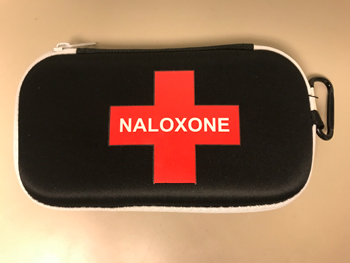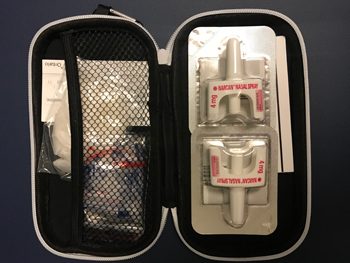Naloxone now available at Emergency Departments to help combat opioid overdoses

By Selma Al-Samarrai

Naloxone kit
Naloxone, a drug that helps reverse an opioid overdose, is now available for free to individuals using opioids and seeking care in the emergency department (ED) at St. Joseph’s Health Centre, and will also be available this fall at the ED in St. Michael’s Hospital.
In addition to the nasal spray Naloxone kits, patients are also offered programs and resources that can help them with their addictions recovery.
“We send an explicit message to our patients and their friends, family and contacts when we hand them Naloxone kits upon discharge – we’re telling them this is a dangerous condition and one that can represent repetitive behaviour,” said Dr. Glen Bandiera, chief of Emergency Department Services at St. Michael’s Hospital.
“We will emphasize that there are treatments available within the system, but also that until they access successful addictions treatment, we want to prevent death by overdose.”
The Ontario Naloxone Program expanded this spring to include hospital emergency departments. Naloxone kits were already available for free in pharmacies and community health centres last year – all in an effort to help combat the opioid crisis in Ontario.
Substance use treatment is multifaceted: it includes medication, pharmacological support, medical support, and psychosocial support.
“The process of dispensing Naloxone keeps people alive so that we can connect them with the services available to support the journey of recovery,” said Leighanne MacKenzie, program director, Inner City Health at St. Michael’s.

Contents of a naloxone kit
When an individual is showing signs of an opioid overdose, Naloxone should be administered immediately either through an intramuscular injection using a needle, or a nasal spray. Naloxone helps the individual breathe normally, regain consciousness, and temporarily reverses the effects of the opioid. Using Naloxone does not eliminate the need for emergency medical attention, so it’s essential that a call is made to 911 immediately as well.
A large majority of opioid overdoses seen in emergency departments are from using street drugs.
“We know addiction issues are seen across all socioeconomic status groups,” said Paula Podolski, administrative director for St. Joseph’s Emergency Department.
“Many who struggle with addictions are either not aware of resources available, or may require multiple attempts to engage them in recovery before they are ready to take the first step.”
Other resources currently offered at St. Joseph’s and St. Michael’s include treatment services such as Rapid Access Clinics, harm reduction services such as needle exchange programs, and specialized programs such as the Toronto Centre for Substance Use in Pregnancy at St. Joseph’s.
To find the nearest location for a free naloxone kit, please click here.
About St. Michael’s Hospital
St. Michael’s Hospital provides compassionate care to all who enter its doors. The hospital also provides outstanding medical education to future health care professionals in more than 29 academic disciplines. Critical care and trauma, heart disease, neurosurgery, diabetes, cancer care, care of the homeless and global health are among the Hospital’s recognized areas of expertise. Through the Keenan Research Centre and the Li Ka Shing International Healthcare Education Centre, which make up the Li Ka Shing Knowledge Institute, research and education at St. Michael’s Hospital are recognized and make an impact around the world. Founded in 1892, the hospital is fully affiliated with the University of Toronto.
St. Michael’s Hospital with Providence Healthcare and St. Joseph’s Health Centre now operate under one corporate entity as of August 1, 2017. United, the three organizations serve patients, residents and clients across the full spectrum of care, spanning primary care, secondary community care, tertiary and quaternary care services to post-acute through rehabilitation, palliative care and long-term care, while investing in world-class research and education.
